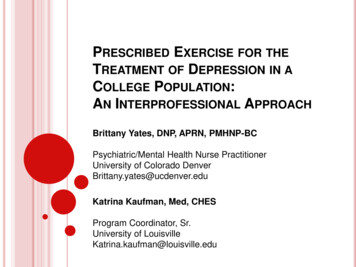
Transcription
PRESCRIBED EXERCISE FOR THETREATMENT OF DEPRESSION IN ACOLLEGE POPULATION:AN INTERPROFESSIONAL APPROACHBrittany Yates, DNP, APRN, PMHNP-BCPsychiatric/Mental Health Nurse PractitionerUniversity of Colorado DenverBrittany.yates@ucdenver.eduKatrina Kaufman, Med, CHESProgram Coordinator, Sr.University of LouisvilleKatrina.kaufman@louisville.edu
CONFLICTS OF INTEREST No conflicts of interest to report. Mention of specific wellness coaching program isnot intended to be endorsement of the product, butrather to demonstrate the benefits of the service inaddressing the problem.
DEPRESSION IN COLLEGE STUDENTS National College Depression Partnership (NCDP) “Unrecognized and untreated depression [wasidentified as the] most common serious public healthproblem in college students” (2015). Background/Significance 32% of college students so depressed it was difficultto function. 7% “strongly considered suicide” (APA, 2013; CDC, 2013; NCDP, 2014, p. 14 NIMH, n.d.; WHO, 2014)
DEPRESSION IN COLLEGE STUDENTS Consequences Increased attrition Decreased productivity and quality of lifeRegular exercise: minimize/prevent depressive symptoms Only 47.4% college students met PH guidelines moderate exercise 30 minutes, on 5 days/weekvigorous exercise 20 minutes, on 3 days/week(APA, 2013; DeRoma et al., 2009; NCDP, 2014; NIMH, 2005; United States Government Accountability Office, 2008 )
EVIDENCE-BASED INTERVENTION Prescribed exercise Exercise as a formal treatment component in a plan ofcare developed by a healthcare practitioner.
PROJECT PURPOSE To establish an interprofessional collaborativeprocess for managing depression treatment forcollege students who have prescribed exercise aspart of their treatment plans.
LITERATURE REVIEW Benefits of exerciseReduced depressive symptoms Increased response/remission rates Increased daily functioning (Blumenthal, et al., 2013; Cooney, et al., 2013; Dunn, et al., 2005; Hughes, et al., 2013; MotaPererira, et al., 2011; Trivedi, et al., 2013) Effective as monotherapy and adjunct (Dunn, et al., 2005; Hughes, etal., 2013; Mota-Pereira, et al., 2013) Exercise: acceptable intervention (Hughes, et al., 2013) Best outcomes with facilitated exercise(Blumenthal, et al., 2007; Dunn, et al., 2005; Hughes, et al., 2013; Rethorst & Trivedi, 2013)
UNIVERSITY OF LOUISVILLECampus Health Services
U-FIT OFFICESTUDENT RECREATION CENTER
Peer wellbeing coaching for UofL Students 20 package includes: Four 1-hour sessions with a peer “Fit Coach” Fitness Assessment Assistance with goal setting Personalized workout recommendation Free t-shirt Connection to other services and units oncampus to support wellbeing
WELLBEING COACHING MODEL Peer fit coaches are trained to use a wellbeing coachingmodel Wellbeing Coaches assist students to: Choose more resilience-building behavior choices Identify barriers to wellbeing and strategies to overcomebarriers Identify strengths and aspects contributing to resilience Determine how to make health-promoting choices moreoften (may include: adjusting food choices, increasingphysical activity, practicing relaxation, improving sleep,quitting smoking, improving sexual health choices, andmore)It’s not about telling students what to do, it’s aboutinvoking critical thought and self-awareness tosupport personal growth.
APPOINTMENT #1 Students meet with their Fit Coach in the SRC forthe first time! This appointment includes:Discussion with Fit Coach about current habits, fitnesshistory, areas of focus, schedule, stress levels, goalsetting, confidence levels, barriers, strengths, andstrategies Fitness assessment: blood pressure, height, weight,body fat percentage, step test, flexibility test, push-uptest Schedule follow up appointment to get results andrecommendations
APPOINTMENT #2 Students meet with their Fit Coach for their results &recommendation. During this appointment studentsreceive: Results of fitness assessment and an explanation for eachmeasurementPersonalized workout recommendation created by Fit CoachWalk through demonstration of each exercise and equipmentuseAdditional resources to support wellbeing: Nutritionappointments, Counseling Center, other services offered byHealth Promotion, etc.Free T-shirtAt the end of the second appointment, studentscomplete the U-Fit evaluation
APPOINTMENT #3 Students meet with their Fit Coach for their follow upappointment to track progress. This typically takes place 4-6weeks after appointment #2. The follow up appointmentincludes: Check-in with fit coachFitness assessment (re-test to track progress from thefirst assessment)Review of fitness assessment results and progress thusfarAdjustments to program recommendation depending onprogress and goal adjustments
APPOINTMENT #4 This is the final appointment and can be used for:Additional fitness assessment to track progress Updates to program recommendation General check-in and goal setting with fit coach
TRAINING FIT COACHES Fit coaches are all peer Health Advocate Leaders 4-day training focusing on protocol, coaching,fitness assessment, building rapport, officelogistics, and practice Shadow sessions and drop-in supervisor evaluation Exercise bank and practice Assistant fit coaches
IMPLEMENTATION Assessment and diagnosis by PL (PMHNP-BC) Development of patient-centered treatment plan Prescribed exercise as formal treatment componentReferral to U-Fit Online scheduling available Baseline PHQ-9 Follow-up PHQ-9 after 4 weeks of exercise
PATIENT HEALTH QUESTIONNAIRE- 9 9-item self-report instrument PHQ-9 scores:5-9 mild depressive symptoms; 10-14 moderate depressive symptoms 15-19 moderately severe depressive symptoms 20 severe depressive symptoms ReliabilityTest-retest: .89 (Kroenke, et al., 2001) Cronbach’s a: .64 (baseline), .57 (follow-up)
SAMPLE DESCRIPTION 10 participants enrolled, 9 completed Mean age: 25.4 years Number exercise days/week: 3.30 1.70 Baseline to follow-up: 47 to 88 (69.22 12.44) Adherence: 2.50 1.18
SAMPLE 4060MajorEngineeringPoli. 02010Education LevelUndergradGraduateDoctoral80280020
SAMPLE DESCRIPTIONVariableFrequencyPercentStudent StatusFull-timePart-time1001000Marital EmployedUnemployed828020
PATIENT CHARACTERISTICSVariableFrequencyPercentTreatment ModalityMedicationMed Therapy555050Referral SourceCounsel. Ctr.CHSOther613601030
RESULTSChange in PHQ-9 ScoresPHQ-9 ScoreMean SDBaseline(Time 1)n 98.78 3.53Follow-up(Time 2)(n 9)5.44 2.92Eta squared: .43tdfp2.468.039
RESULTS Participant U-Fit evaluation forms:Increased motivation Enhanced knowledge re: exercise Individual self-reports Anecdotal feedbackPHQ-9 scores decreased in all but one participant
AGENCY BENEFIT 2014- CHS joined the National College DepressionPartnership (NCDP) Early identification and implementation ofevidence-based treatment for college studentswith depression Accreditation Quality improvement measures(NCDP, 2014)
DISCUSSION Results consistent with literature Exercise is effective, feasible treatment option Reduction in depressive symptoms At dose consistent with PH guidelines Adherence to facilitated prescribed exercise Acceptability of intervention
CONCLUSION Able to establish feasible interprofessional processto address problem in college population Participants responded positively to intervention Support for exercise may improve outcomes Established collaborative process for referrals to UFit
REFERENCES American Psychiatric Association. (2013). Diagnosticand statistical manual of mental disorders: DSM-5.United States: American Psychiatric Association.Blumenthal, J. A., Babyak, M. A., Doriaswamy, P. M.Watkins, L., Hoffman, B. M., Barbour, K. A., Herman, S.,Craighead, W. E., Brosse, A. L., Waugh, R., Hinderliter,A., & Sherwood, A. (2007). Exercise andpharmacotherapy in the treatment of major depressivedisorder. Psychosomatic Medicine, 69, p. 587-596.Retrieved from /illiad.dll?Action 10&Form 75&Value 232794Centers for Disease Control and Prevention. (2013).Mental health: depression. Retrieved llness/depression.htm
REFERENCES Cooney, G. M., Dwan, K., Greig, C. A., Lawlor, D. A., Rimer, J., Waugh,F. R., McMurdo, M., & Mead, G. E. (2013). Exercise for depression(review). The Cochrane Library, 9. Retrieved ContentServer.asp?T P&P AN&K CD004366&S R&D chh&EbscoContent ntCustomer dGJyMPGusU20prdQuePfgeyx44Dt6fIADeRoma, V. M., Leach, J. B., & Leverett, J. P. (2009). The relationshipbetween depression and college academic performance. CollegeStudent Journal, 43. Retrieved ge-StudentJournal/201608594.htmlDunn, A. L., Trivedi, M. H., Kampert, J. B., Clark, C. G., & Chambliss, H.O. (2005). Exercise treatment for depression: efficacy and doseresponse. American Journal of Preventative Medicine, 28, p. 1-8.Retrieved ost/detail/detail?vid 3&sid 3&hid 114&bdata JnNpdGU9ZWhvc3QtbGl2ZSZzY29wZT1zaXRl#db psyh&AN 2005-00701-001
REFERENCES Hughes, C. W., Barnes, S., Barnes, C., DeFina, L. F., Nakonezny, P., &Emslie, G. J. (2013). Depressed adolescents treated with exercise (DATE): apilot randomized controlled trial to test feasibility and establish preliminaryeffect sizes. Mental Health and Physical Activity, 6, p. 119-131.Kroenke, K., Spitzer, R. L., & Williams, J. B. W. (2001). The PHQ-9: Validity ofa brief depression severity measure. The Journal of General InternalMedicine, 16, p. 606-613. Retrieved /ehost/command/detail?sid 05&vid 4&hid 4106Krogh, J., Saltin, B.,Gluud, C., & Nordentoft, M. (2009). The DEMO trial: a randomized, parallelgroup, observer-blinded clinical trial of strength versus aerobic versusrelaxation training for patients with mild to moderate depression. Journal ofClinical Psychiatry, 70, p. 790-800.Mota-Pereira, J., Silverio, J., Carvalho, S., Ribeiro, J. C., Fonte, D., & Ramos,J. (2011). Moderate exercise improves depression parameters in treatmentresistant patients with major depressive disorder. Journal of PsychiatricResearch, 45, p. 1005-1011. Retrieved ost/detail/detail?vid 5&sid 3&hid 114&bdata JnNpdGU9ZWhvc3QtbGl2ZSZzY29wZT1zaXRl#db psyh&AN 2011-16197-003
REFERENCES National College Depression Partnership. (2015). Nationalcollege depression partnership: supporting student learning byovercoming depression. Retrieved l College Health Association. (2014). National collegehealth assessment: University of Louisville executivesummary. Retrieved orWebsite.pdfNational Institute of Mental Health. (2005). Mental illnessexacts heavy toll, beginning in youth. Press Release.Retrieved from mlNational Institute of Mental Health. (n.d.). What is depression?Retrieved on/index.shtml#part1
REFERENCES Rethorst, C. D., & Trivedi, M. H. (2013). Evidence-basedrecommendations for the prescription of exercise for majordepressive disorder. Journal of Psychiatric Practice, 19, 204212. doi: 10.1097/01.pra.0000430504.16952.3eTrivedi, M. H., Greer, T. L., Church, T. S., Carmody, T. J.,Grannermann, B. D., Galper, D. I., Dunn, A. L., Earnest, C. P.,Sunderajan, P., Henley, S. S., & Blair, S. N. (2013). Exerciseas an augmentation treatment for nonremitted majordepressive disorder: a randomized, parallel dose comparison.Journal of Clinical Psychiatry, 72, p. 677-684.United States Government Accountability Office. (2008).Young adults with serious mental illness: some states andfederal agencies are taking steps to address their transitionchallenges. Retrieved fromhttp://www.gao.gov/new.items/d08678.pdfWorld Health Organization. (2014). Depression. MentalHealth. Retrieved fromhttp://www.who.int/mental health/management/depression/en/
Exercise RxAmerican College Health AssociationWilliam Mupo, MPAJune 2nd, 2017
Demographics and CorrelatesWHO IS NOT AND WHO IS EXERCISINGAT UT AUSTIN (AND DO THEY CARE)
Demographics and ACSM GuidelinesMenWomenAll UT Students57%50%Greek Affiliated63%53%Self-reported GPA: A58%53%Feel Connected to aCommunity (Agree orStrongly t in a Relationship56%53%International51%51%Listed percentage is percent meeting Aerobic Guidelines
Year in School and ACSM GuidelinesPercent of Students Meeting ACSM Aerobic Guidelines70%65%64%62%60%55%50%14% pt56%53%51%13% pt54%53%10% pt50%49%46%45%40%First YearSecond YearThird YearMenWomenFourth/Fifth YearGraduate School
2017 NCHA Met vs. Did Not Meet ACSM Aerobic GuidelinesNot MetMetOverweight22%21%Obesity9%8%Fair or Poor General Health20%10%0-2 Servings Fruits and Vegetables75%61%Difficult to handle- personal appearance28%23%Sleep difficulties31%24%Diagnosed with Depression12%9%More than Average to Tremendous Stress55%52%Felt Hopeless- last 12 months55%49%Felt Overwhelming Anxiety- last 12 months61%55%Felt Very Sad- last 2 weeks68%66%Generally Unhappy ( 4 on 7 point scale)18%8%% of students met guidelines
Interest and Receiving Information on Physical ActivityConditionInterested in InformationReceived 63%Depression62%57%More than Average Stress66%62%Difficulty falling asleep 2 nights66%63%Unhappy71%60% 66% of students meeting ACSM guidelines are interested in receiving physical activityinformation 63% of students not meeting ACSM guidelines are interested in receiving physical activityinformation
Interest and Receiving Information on Physical ActivityInterested in on
2017 NCHA- Top Health PriorityMale %Alcohol UseDrug UseHealthy SexualityNutritionPhysical ActivitySleepStressTobaccoOtherNoneFemale %10%4%8%54%71%49%41%4%2%3%7%2%8%61%71%53%57%1%4%3%
WHY HAVE AN EXERCISE RXPROGRAM
Challenge and Opportunity Reaching disconnected students Power of a provider’s suggestion andcounseling: Evidence base Integrating clinical care and public healthBening, et al; Greenlund, et al;Frank, et al; Lobelo, et al; Sallis, et al;Crookham, et al; Duncan, et al,Pedersen, et al; Grandes, et al; Berra,et al; Sanchez, et al, Phillips, et al
Program Origins Research Review Kinesiology and Health Communication ClassFeedback Dell Children’s Hospital
What Works in Changing Physical Activity Behavior Prompts and Cues Action Planning Time Management Instruction Self Monitoring Social Comparison Behavioral Consequences Social Comparison andSupportWilliams, et al; Olander, etal; Michie, et al
IMPLEMENTATION PART 1CURRENT STATE
ProcessScreening Conditionsand IntakeDiscussionwith student MotivationalInterviewing ActionPlanningRx ResourceGuide Referral
Resource Guide Addressing Issues to Starting– Time– What to do Key Messages– Small changes done consistentlymake a big difference– Activity doesn’t need to beregimented but time for it should be planned– Explore different programs and resourcesto find ones you enjoy
Resource Guide Sections Exercise Rx PageCardiovascular Exercise TipsStrength Training TipsWorkout NutritionSetting Yourself Up for SuccessCampus Resources and ProgramsAustin Bucket ListGeneral Activity Tips and Acknowledgements
Make Your Physical Activity Bucket ListRun, Jog, Walk, or Bike the Hikeand Bike Trailsand Barton Creek GreenbeltClimb to the top of the360 Bridge AreaFitness with friendsWhat physical activities do you want to do at UT?Learn a newsport or skillView Austin fromMount BonnellKayak or Paddle Boardat Town Lake
Referral Meeting Discussion– Past experience with exercise– Enjoyable activities– Goals and Schedule– Past success and feelings Resources and Strategies– Identify Follow Up– Student and referring physician
Clinic Volunteer RoleIMPLEMENTATION PART 2FUTURE GOALS
Clinic Volunteer Roles Peer support Discussing programs and resources In-depth action planning
EVALUATION
INPUTSActivitiesOUTPUTSUHS providersAuthor resource guide# of providers trainedCMHC providersWrite guidancedocument# of providersimplementing theprogramHPRC staffClinic volunteersWeb designCreative designPrintingRecSports staffConduct trainings forproviders andvolunteers# of volunteers trainedPublish on web# of volunteersconductingconsultationsProvider conductingexercise conversationwith patientProvider distributingresource guide topatientClinic volunteerconsultation withpatientInclude evaluationquestion on patientsurveyAssumptions# of patients counseledon exercise by provider# of patients consultingwith clinic volunteers# of resource guidesdistributed (print)# of resource guidesaccessed via web# of patientsresponding toevaluationShort-TermIncrease numberof providers whodiscuss exercisewith patientsIncrease providercomfort withdiscussingexerciseOUTCOMESMedium-Term Increase numberIncreasenumber ofof referralspatientsusing Increaseenrollmentphysicalactivity inBASICSresources Decrease numberof no showsIncreasenumber ofdays patients arephysically activeIncrease patientawareness ofphysical activityresourcesDecrease number ofpatients who engagein no physicalactivityIncrease patientmotivation toexerciseIncrease number ofpatients meetingACSM aerobicguidelinesIncrease numberof patientsinitiating physicalactivityIncrease inpatient selfefficacy to bephysically activeIncrease number ofpatients meetingACSM musclestrengtheningguidelinesExternal FactorsLong-TermDecrease indepressivesymptomsDecrease in anxietysymptomsDecrease inobesity/overweightDecrease inhypertensionDecrease in othercardiovasculardisease risk factorsIncrease in selfreported feeling ofhealth (HRQL)Increase inmuscular strengthIncrease in aerobiccapacity
Questions and Discussion
Thank texas.edu/HT/HT T/HT exerciseessentials.html
Brittany Yates, DNP, APRN, PMHNP-BC Psychiatric/Mental Health Nurse Practitioner University of Colorado Denver Brittany.yates@ucdenver.edu Katrina Kaufman, Med, CHES Program Coordinator, Sr. University of Louisville Katrina.kaufman@louisville.edu. . Retrieved from https://eku-illiad-oclc-











